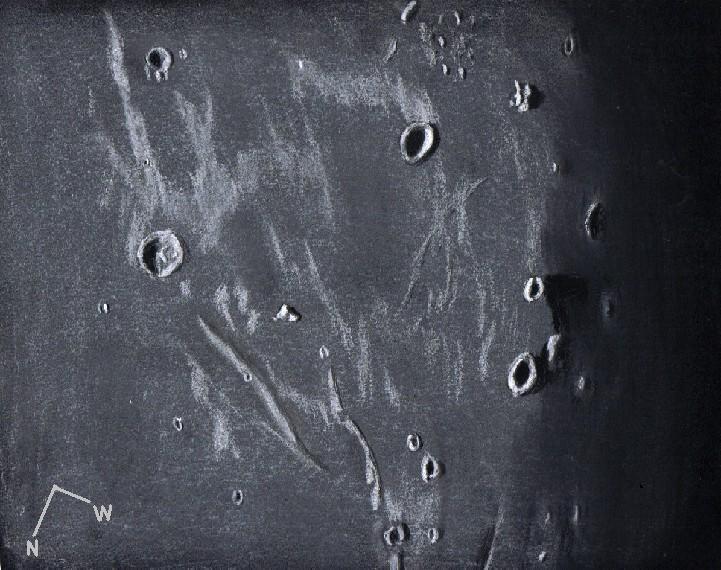Mare Imbrium
Sketch and Details by Frank McCabe
Ray debris from crater Copernicus can be seen cast across this distant region of Mare Imbrium.
The first crater visible to the southeast (upper left) is 20 kilometer Pytheas. Like many of the craters in this part of the lava covered floor, it is from the Eratosthenian period and unlike the younger Copernican period craters does not display fresh crater rays. Northward the largest crater in this sketch is Lambert (30 km.). The inner wall terraces as well as the central craterlet were visible but the buried ghost crater Lambert R was not seen to the south with the higher sun angle here. To the west of Lambert the pair of bright spots is mons La Hire a solitary lunar mountain and remnant of the lunar highlands not covered over by lava. North of mons La Hire and projecting straight to the northwest is Dorsum Zirkel a wrinkled ridge of 200 kilometers length. Another shorter ridge to the northwest is Dorsum Heim which arcs to the northeast of crater Caroline Herschel (14 km.). The crater to the west of Pytheas and Lambert is Euler a 28 kilometer shadowed floor cavity with a brightly illuminated inner wall on the western side. Beyond this crater to the west southwest is the irregular, complex mountain feature mons Vinogradov an old Imbrian feature. On to the north northwest along the terminator are craters Diophantus (19 km.) and Delisle (25km.) with mons Delisle in between and closer to the crater of the same name. A dorsum or ridge or perhaps a buried crater rim creates a sharp curving demarcation between illumination and darkness along the terminator.
I would have preferred to use higher magnification during this observation but the wind was gusty and making observation a challenge.
Sketching:
For this sketch I used: black Strathmore 400 Artagain paper, 8”x 11”, white and black Conte’pastel pencils and a blending stump. Brightness was slightly decreased (-2) and contrast increased (+3) after scanning using Microsoft Office Picture Manager.
Telescope: 10 inch f/5.7 Dobsonian and 12mm eyepiece 121x
Date: 4-16-2008 3:36 – 4:15 UT
Temperature: 9°C (48°F)
clear, windy
Seeing: Antoniadi III
Co longitude: 35.4°
Lunation: 10 days
Illumination: 82.9 %
Phase: 48.8°
Observing Location: +41°37′ .. +87° 47′
Frank McCabe

